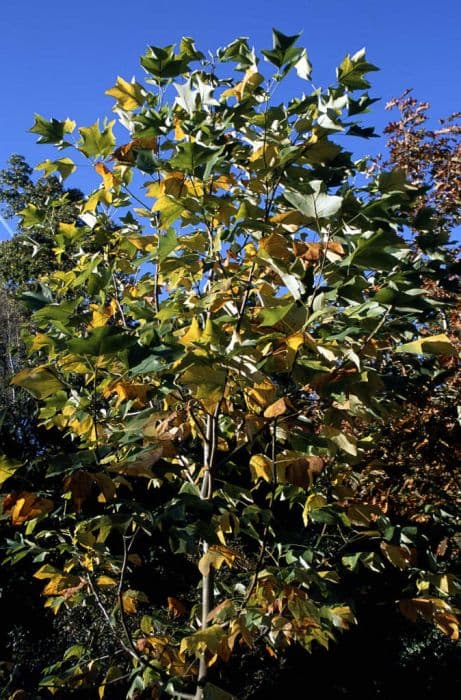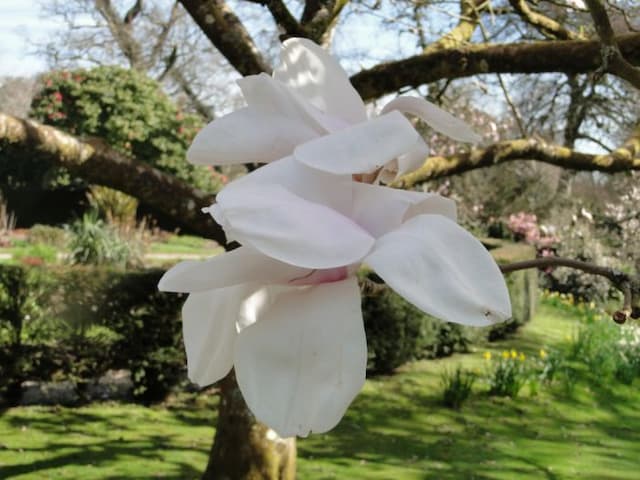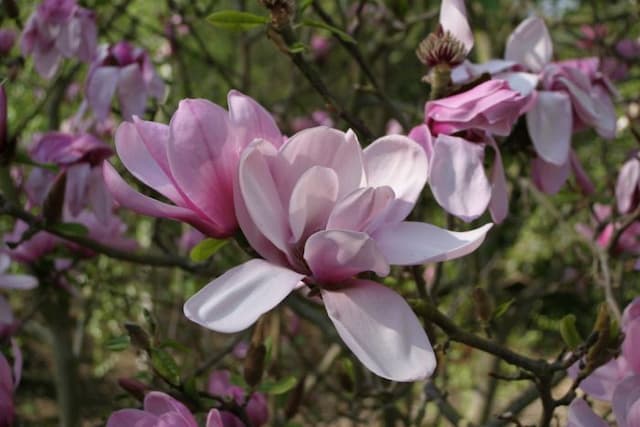Magnolia Felix Jury Magnolia Felix Jury = 'Jurmag2' (PBR)
![magnolia [Felix Jury]](/_next/image?url=https%3A%2F%2Fplants-admin.emdemapps.com%2Fimages%2Fplants%2F%2Fimages%2F604b61a0b23b7.png&w=3840&q=75)
ABOUT
The Magnolia Felix Jury, known by its catchy name 'Jurmag2' with Plant Breeder's Rights (PBR), is a visually stunning variety of the magnolia family. This plant is recognized by its large, showy flowers that make it a standout in any garden setting. The blossoms are cup-shaped and can be described as being deeply colored. They often exhibit a rich pink or purple hue on the outside, adding a romantic feel to the plant's appearance. As the flowers open, the petals may spread and reveal a lighter, often creamy-white or blush-pink interior, creating a lovely two-tone effect that is quite alluring. These opulent flowers emit a delightful fragrance that can fill the surrounding area with a sweet, heady aroma, making them not only a treat for the eyes but also for the sense of smell. The leaves of the Magnolia Felix Jury provide an attractive backdrop to the blooms. They are glossy and dark green, which contrasts nicely with the flamboyant colors of the flowers. The leaves are broad and can have a smooth or slightly wavy edge. They are thick and leathery to the touch. During the blooming period, which is typically in the early stages of the growing season, this magnolia becomes the star of the space it occupies, with the flowers dominating the visual interest. When not in bloom, the plant maintains its appeal with its lush foliage and pleasing, sturdy form. Overall, the Magnolia Felix Jury is a striking specimen that combines dramatic color, fragrance, and a commanding presence to delight onlookers and enhance any landscape where it is planted.
About this plant
 Names
NamesFamily
Magnoliaceae
Synonyms
Felix Jury Magnolia
Common names
Magnolia 'Jurmag2' Felix Jury.
 Toxicity
ToxicityTo humans
The Magnolia, including the cultivar known as 'Felix Jury', is generally not considered toxic to humans. They are widely planted in gardens and public spaces with a low incidence of poisoning. However, like with any plant, individuals may have varying sensitivities, and ingesting plant material in large quantities could potentially cause stomach upset or an allergic reaction in some people. It is always advisable to avoid eating plant parts if the edibility is uncertain.
To pets
The Magnolia, including 'Felix Jury', is generally regarded as non-toxic to pets. It does not commonly cause poisoning in animals such as dogs and cats. While the magnolia is safe for pets, it is always best to prevent pets from consuming plants, as individual animals might have unique sensitivities, and ingesting any non-food material can potentially lead to gastrointestinal upset or an obstruction.
 Characteristics
CharacteristicsLife cycle
Perennials
Foliage type
Deciduous
Color of leaves
Green
Flower color
Pink
Height
20 feet (6 meters)
Spread
15 feet (4.5 meters)
Plant type
Tree
Hardiness zones
7
Native area
Cultivar
Benefits
 General Benefits
General Benefits- Large showy flowers: Magnolia 'Felix Jury' features particularly large and vibrant blooms that add aesthetic appeal to any garden.
- Long blooming period: This magnolia variety offers an extended flowering season, providing color and interest for longer periods.
- Ornamental value: With its striking flowers and grand presence, this magnolia serves as a focal point in landscape design, enhancing the overall beauty of gardens and parks.
- Drought tolerance: Once established, it can survive with less water, making it suitable for regions with water restrictions or low rainfall.
- Pollinator-friendly: The flowers attract beneficial pollinators such as bees and butterflies, supporting biodiversity.
- Seasonal interest: Provides year-round interest with its flowers in spring, lush foliage in summer, and textured seed pods and framework in autumn and winter.
- Shade-providing: The wide canopy offers shade in garden spaces, making it a practical addition for sunny areas.
- Low maintenance: Generally requires minimal care once established, making it an ideal choice for both novice and experienced gardeners.
 Medical Properties
Medical PropertiesThis plant is not used for medical purposes.
 Air-purifying Qualities
Air-purifying QualitiesThis plant is not specifically known for air purifying qualities.
 Other Uses
Other Uses- Magnolia Felix Jury can be used as a natural dye source for fabrics, providing a range of colors depending on the mordant used.
- The large petals of Magnolia Felix Jury can be utilized in craft projects, such as making floral-themed bookmarks or pressed flower art.
- Its wood, being fairly hard and dense, may be carved into small ornamental items or used in fine woodworking projects.
- The fallen leaves of the Magnolia Felix Jury can be collected and used as a natural mulch in gardens to suppress weeds and retain soil moisture.
- The flowers can be used in perfumery, capturing the magnolia's distinctive fragrance for scented candles, oils, and other aromatic products.
- Petal-infused water from Magnolia Felix Jury can be used as a soothing facial rinse or added to bathwater for a fragrant soak.
- The tree's bark and branches can be used for decorative purposes, such as making wreaths or as accents in floral arrangements.
- Magnolia Felix Jury's seed pods, once dried, make interesting additions to dried flower arrangements or can be used in crafting unique jewelry pieces.
- Dried and pressed leaves of the Magnolia Felix Jury can be laminated to create naturalistic bookmarks or decorative placemats.
- The Magnolia Felix Jury's distinctive shape and foliage can be used in landscaping to create privacy screens or windbreaks.
Interesting Facts
 Feng Shui
Feng ShuiThe Magnolia is not used in Feng Shui practice.
 Plant Symbolism
Plant Symbolism- Perseverance and Endurance: Magnolias are known for their hardiness and longevity, often living for many years. They symbolize the ability to withstand adversity and keep flourishing.
- Dignity and Elegance: With their large, showy flowers, magnolias are often associated with a graceful strength and a refined beauty, reflecting an air of nobility and poise.
- Purity and Innocence: The magnolia's pristine white flowers can represent the purity of the heart and the innocence that comes with a clear conscience.
- Nobility: In ancient cultures, magnolias were often associated with nobility due to their impressive appearance and the fact that they are one of the oldest flowering plants, linking them to a regal lineage.
- Femininity and Beauty: The soft and delicate form of the magnolia flower has made it a symbol of femininity and the beauty of womanhood.
- Love of Nature: Magnolias often grow in wild, natural settings, which can represent a deep appreciation for and harmony with the natural world.
 Water
WaterThe Magnolia 'Felix Jury' should be watered deeply to ensure that the moisture reaches the root zone, and the frequency of watering depends on the climate and soil conditions. In general, during the growing season, water the plant about once a week with approximately 1.5 gallons per session, ensuring the soil stays consistently moist but not waterlogged. During hotter, dry spells, increase the watering frequency to every 3-4 days. In the winter, reduce watering to match the plant's reduced need for moisture. Always check the top few inches of soil for dryness before watering to avoid overwatering.
 Light
LightFor optimal growth, the Magnolia 'Felix Jury' should be planted in a spot where it receives full to partial sunlight. An ideal location would be one that gets direct morning sunlight but is shaded from the intense afternoon sun, especially in hotter climates. Avoid deep shade, as it can lead to sparse flowering and leggy growth.
 Temperature
TemperatureThe Magnolia 'Felix Jury' is tolerant of a range of temperatures and can survive minimum temperatures as low as 20 degrees Fahrenheit. Ideally, it thrives in areas with typical daytime temperatures between 60 and 80 degrees Fahrenheit. Protecting the plant from extreme cold and frost is essential, so in regions where temperatures drop below freezing, additional winter protection may be required.
 Pruning
PruningPrune the Magnolia 'Felix Jury' to remove dead or damaged wood and to shape the tree, which encourages healthy growth and improves air circulation. The best time to prune is in late winter or early spring before new growth starts. Light pruning can be done as needed throughout the year, but heavy pruning should be reserved for the dormant season. Prune no more than one-third of the tree in a single year to avoid stressing the plant.
 Cleaning
CleaningAs needed
 Soil
SoilFelix Magnolia prefers well-draining, organic-rich soil with acidic to neutral pH between 5.0 and 7.0. A mix of peat, compost, and pine bark suits it well.
 Repotting
RepottingFelix Magnolia, being a sizable tree, is not commonly repotted. It should be planted in a location where it can grow undisturbed.
 Humidity & Misting
Humidity & MistingFelix Magnolia thrives in average outdoor humidity levels; it does not require any special humidity conditions.
 Suitable locations
Suitable locationsIndoor
Place Felix Magnolia near a bright window; water when topsoil feels dry.
Outdoor
Plant Felix Magnolia in partial sun, sheltered from strong winds.
Hardiness zone
7-10 USDA
 Life cycle
Life cycleThe Magnolia 'Felix Jury' starts its life cycle when a seed germinates in well-drained soil with adequate warmth and moisture. As a seedling, it develops a basic root system and a stem with juvenile leaves. As it enters the juvenile stage, it grows more rapidly, forming a more extensive root system and a sturdy trunk, while growing its distinctive large, glossy green leaves. Upon reaching maturity, which could take several years, it begins its reproductive phase, producing large, showy flowers typically in early spring, with flowering continuing as the tree ages. The flowers are pollinated by insects like bees, and following pollination, it develops fruit that contains seeds, which when dispersed, can give rise to new plants. As an established tree, it continues to grow in height and width, and can live several decades, maintaining cycles of flowering and seed production annually.
 Propogation
PropogationPropogation time
Spring-Early Summer
Propogation: The Magnolia Felix Jury, known for its spectacular blooms, is typically propagated by softwood cuttings during the late spring to early summer months. This is when the plant's new growth is just beginning to harden but is still flexible. Gardeners often select a healthy, non-flowering shoot and cut a piece about 4-6 inches (10-15 cm) in length. The bottom end of this cutting is then dipped in rooting hormone to encourage root development and planted in a pot filled with a mix of peat and perlite for drainage. The cutting should be kept in a humid environment, often achieved by covering the pot with a plastic bag or placing it in a greenhouse to prevent moisture loss. Once roots have established, usually within a few weeks to a few months, the new Magnolia Felix Jury plant can be transferred to a larger pot or directly into the garden.









